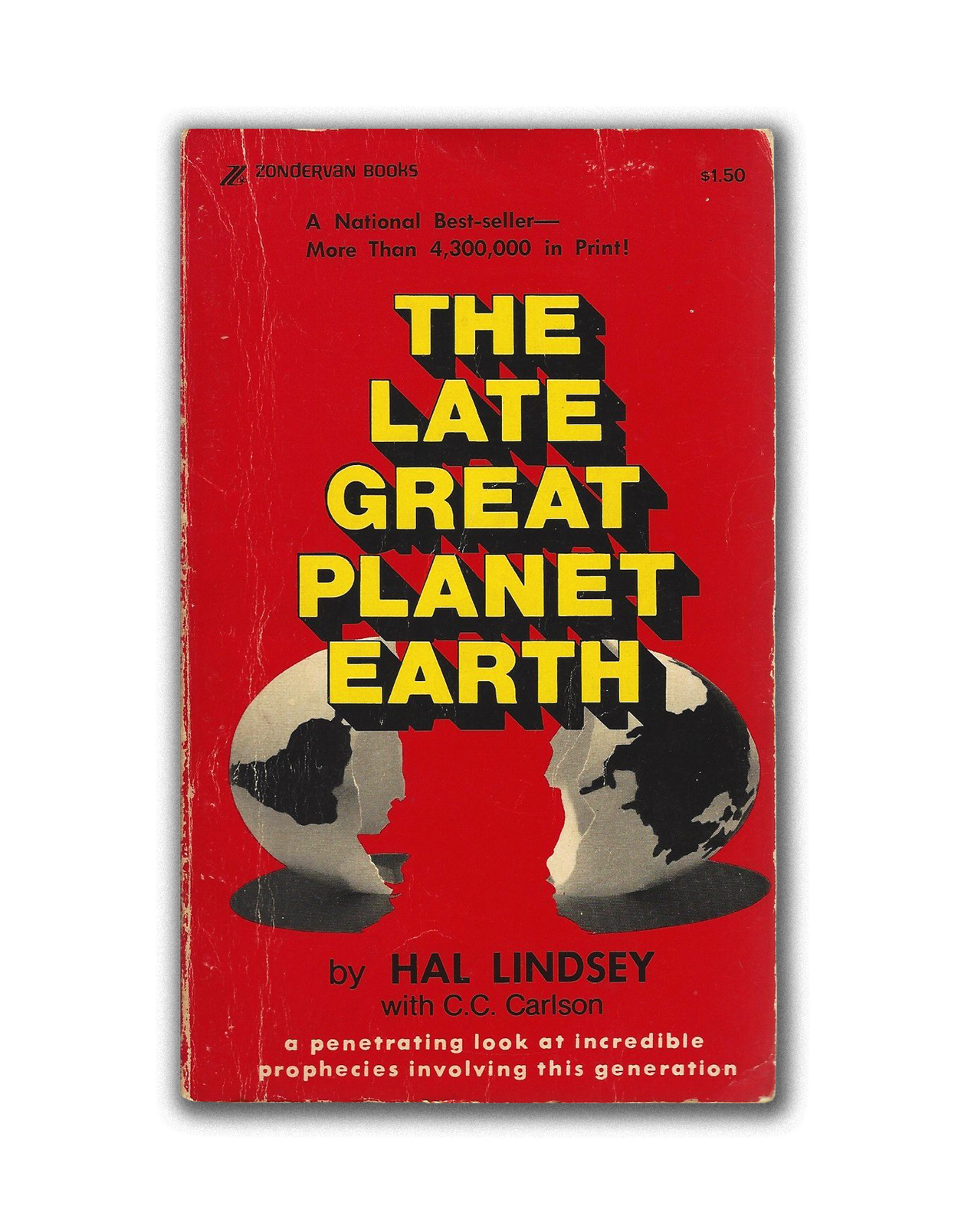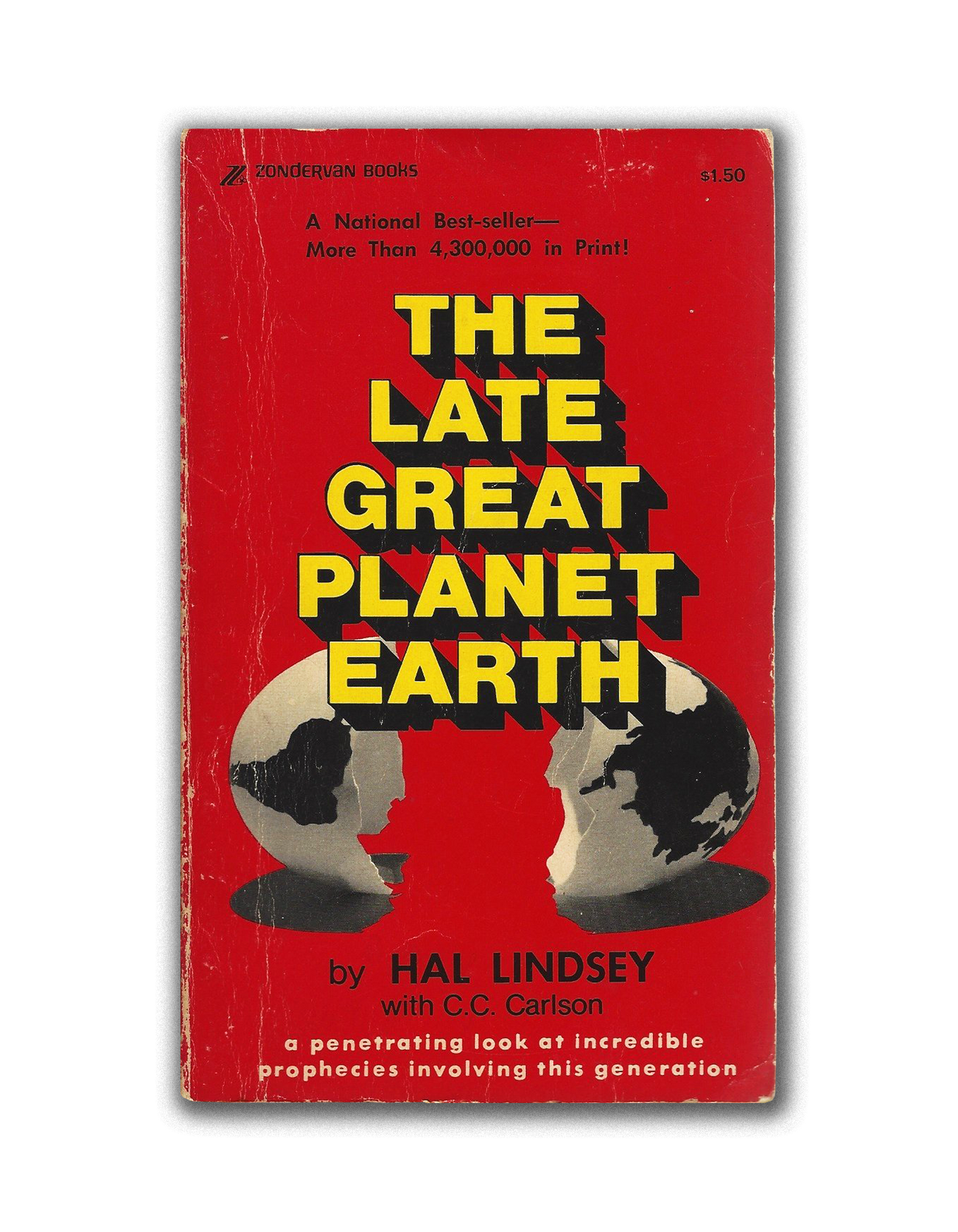The State of Israel as the Gateway to End Times
Hal Lindsey’s ‘The Late Great Planet Earth’ at 50




On the colorful cover of the 1991 HarperCollins paperback edition of Hal Lindsey’s The Late Great Planet Earth, the publishers note that “15 million copies are in print.” The back cover presents the book’s premise that “over the past few decades, most of the predictions made in the Old and New Testaments have in fact come true: the rebirth of Israel, unrest in the Middle East, the revival of interest in Satanism.”
The Late Great Planet Earth (LGPE) was first published in 1970 by Zondervan Press, which describes itself as “a world-leading Bible publisher and provider of Christian communications.” The HarperCollins reprint of the original Zondervan publication was occasioned by the outbreak of the 1991 Gulf War, which many Americans understood as an event fulfilling biblical prophecies about Babylon and the End Times. While the End Times may not have arrived in the 1990s, the fusion of evangelical Christianity and politics certainly did; by the turn of the millennium, LPGE had sold over 25 million copies.
In LPGE, Hal Lindsey was not presenting new ideas, but reviving old ones—very old ones, if we are thinking of the Bible; more recent ones if we consider early 20th-century history. The Balfour Declaration of 1917, facilitated by Balfour’s Christian Zionist leanings, elicited great enthusiasm among many Protestant preachers, heralding a moment when the world as we know it would end and the redemptive process would begin. Linking the Bible to End Times speculation was, and is, a Protestant project, not a Catholic one: The Reformation’s emphasis on a historical and literal approach to understanding the Bible led to centuries of speculation and activism in anticipation of the Second Coming. For biblical literalists, the “return of the Jews to their land” is the sign of God’s promise fulfilled.
Many American Protestants were equally enthusiastic about the restoration of the Jews to their homeland. Prominent American Protestant leader W. Fuller Gooch summed up the American evangelical reaction to the Balfour Declaration in a March 1918 sermon: “Palestine is for the Jews. The most striking Sign of the Times is the proposal to give Palestine to the Jews once more. They have long desired the land, though as yet unrepentant of the terrible crime which led to their expulsion … There is a mass of Prophetic Scripture yet to be accomplished until Palestine is again in Jewish hands. Prophecy revolves around the despised Jew; and if Jewish restoration is imminent (as it appears to be), how near we must be to the fulfillment of every vision!”
In Gooch’s sermon, we have the basic elements of Christian Zionism’s complex and tortuous relationship to Judaism: condemnation of the Jews for rejecting Jesus, coupled with the hope that “Jewish restoration” is the sign of redemption.
Christian fundamentalists saw the establishment of the State of Israel in 1948 as a further “sign of the times,” a fulfillment of the promise inherent in the events of 1917. This “sign” was especially relevant for dispensationalists, followers of 19th-century British preacher John Nelson Darby, the author and preacher who formulated the prophecy doctrines of those who anticipated the imminent final dispensation, or epoch, of history. In the mid-19th century, Darby brought his ideas to the United States, where they influenced seminary students at the Moody Bible Institute of Chicago. Later, in the 20th century, these ideas were dominant at the Dallas Theological Seminary.
Most effective in spreading Darby’s ideas was the Scofield Reference Bible, which became the Bible of American fundamentalism. Published in 1909 by Oxford University Press, this special edition of the King James Bible assigned specific dates to all of the biblical narratives, thus buttressing dispensational claims of biblical inerrancy and of the fulfillment of biblical prophecy in modern times. The Scofield Bible’s successor, the Ryrie Study Bible, makes specific and pointed references to the history of modern Israel, treating it as a continuation of the biblical narrative. Thus, many American Christians saw Jewish Zionists as “un-knowing instruments” of a divine process that would in time bring about a Jewish acceptance of Jesus, a belief that led many Jews to see evangelical Christians as missionaries and distance themselves from them. This distancing ended in the 1970s, when Christian Zionists and the ideologues of the settler movement began the complicated dance that would lead in the ’90s to the settler-Christian Zionist alliance.
For Christian Zionists between 1948 and 1967, as for many Jewish religious Zionists, one essential element of prophecy had yet to be fulfilled—the extension of Israeli rule to Jerusalem’s Temple Mount. Once that rule was established, Israel, in their view, could proceed with the rebuilding of the Temple and the revival of the Temple sacrifices, both essential steps in the ushering in of the End Times. Like many religious Zionists, these Christians saw “the hand of God” in the Israeli victory of 1967, and they endorsed the view that the creation of a “Greater Israel” was Israel’s divine destiny. Any peace effort, therefore, would be an act against God.
Soon after the end of the 1967 war, the American evangelical journal Christianity Today published an article by Nelson Bell, editor of the journal and father-in-law of Billy Graham. Bell wrote, “That for the first time in more than two thousand years Jerusalem is now completely in the hands of the Jews gives a student of the Bible a thrill and renewed faith in the accuracy and validity of the Bible. If the hand of God was visible in history as it unfolded, it would be presumptuous and rebellious to try and negotiate between the hostile nations and peoples.”
A few years later, in 1970, Hal Lindsey, a lecturer for Campus Crusade for Christ, wrote The Late Great Planet Earth, which outlined the dispensationalist understanding of God’s plan for Israel and the world. Describing the capture of Jerusalem in 1967, Lindsey wrote, “Again, against incredible odds, the Jews had unwittingly further set up the stage for their final hour of trial and conversion.” Lindsey, educated at Dallas Theological Seminary, the bastion of dispensationalist thought, called the State of Israel “the fuse of Armageddon.” The Jewish state, in fulfillment of New Testament prophecy, would rebuild the Temple. Lindsey claimed that “There remains but one more event to completely set the stage for Israel’s part in the last great act of her historical drama. This is to rebuild the ancient Temple of Worship upon its old site.”
The Late Great Planet Earth has influenced generations of evangelical Christians. The book had tremendous appeal for American college youth of the early 1970s, particularly in the South. In the words of a college student of the early 1970s: “As a college freshman in 1971, I brought a copy of The Late Great Planet Earth with me to Auburn University. Everyone on my wing of the dormitory, Christian and non-Christian alike, read the book that year. It scared us to death. We thought the end was near.” In subsequent books, Hal Lindsey further developed his eschatology and presented Islam as the greatest threat to world survival.
David Ben-Gurion, living in retirement in the Negev when The Late Great Planet Earth was published, took a lively interest in the book and its popularity in the United States. Ben-Gurion was very familiar with Christian Zionist ideas. In the late 1950s and early 1960s, he had welcomed prominent American churchmen to Israel, among them Oral Roberts, who visited Israel in 1959. And I imagine that Israel’s “Founding Father” was informed that he was quoted in LGPE. The chapter in which Lindsey dubs the State of Israel “the fuse of Armageddon,” opens with this statement of Ben-Gurion’s:
“There are few countries which have played so central a role in world history as the Land of Israel.”
In 2015, Philip Earl Steele, a scholar of Christian Zionism, confirmed that he found a copy of Lindsey’s book on top of a stack of books on Ben-Gurion’s chair at his home at Kibbutz Sde Boker in the Negev. A British journalist reported that Menachem Begin, Israel’s prime minister from 1977 to 1983, also took a lively interest in Lindsey’s book.
Another prominent Israeli quoted approvingly in LGPE was Israel Eldad, an ideological leader in Revisionist Zionism and a founder of the Movement for Greater Israel. Identified in LGPE as “a famous Israeli historian,” Eldad’s remarks about rebuilding the Temple closed the chapter that opened with the quote from Ben-Gurion. Shortly after the 1967 war, Eldad told an American reporter that the Third Temple would have to be built within a generation of the Israeli conquest of the eastern part of Jerusalem. “From the time that King David first conquered Jerusalem until Solomon built the Temple, just one generation passed. So will it be with us.” To the reporter’s subsequent question, “What about the Dome of the Rock which now stands on the Temple site?” Eldad replied, “It is of course, an open question. Who knows, maybe there will be an earthquake.” Lindsey’s comment on this exchange was, “The hope of rebuilding the Temple that is present in the hearts of devout Jews, some of whom are in powerful positions in the Israeli government, was clearly reflected here … For all those who trust in Jesus Christ, it is a time of electrifying excitement.”
In LGPE Lindsey also tells of his time as a missionary for Campus Crusade for Christ:
“In March and April of 1967, I was lecturing on this subject at many college campuses on the West Coast. I said that if this was the time that I thought it was, then somehow the Jews were going to have to repossess old Jerusalem. Many chuckled about that statement. Then came the war of June, 1967—the phenomenal Israeli six-day blitz. I was personally puzzled as to the significance of it all until the third day of fighting when Moshe Dayan, the ingenious Israeli general, marched to the wailing wall, the last remnant of the Old Temple, and said, ‘We have returned to our holiest of holy places, never to leave her again.’ Needless to say, I received quite a few phone calls after that. Again, against incredible odds, the Jews had unwittingly further set up the stage for their final hour of trial and conversion.”
The word “unwittingly” keeps coming up in dispensationalist writings about Zionism. The implication is that the Zionist movement’s Jewish supporters thought that the endpoint of their efforts was the establishment of a Jewish state. But for Lindsey and millions of his readers, that assumption was mistaken. The real purpose behind Zionism, according to LGPE, was to aid in the fulfillment of New Testament prophecy.
Shalom Goldman is Professor of Religion at Middlebury College. His most recent book is Starstruck in the Promised Land: How the Arts Shaped American Passions about Israel.